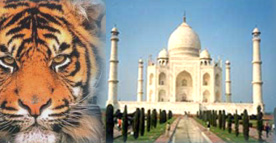India is an amazing country, the history of its people going back several millennia. Having cradled some of the oldest known civilizations of the world, this amazingly diverse land saw the emergence of some of the mightiest empires and dynasties of the ancient and medieval world. Over a period of several centuries, numerous rulers have come and gone, leaving behind their marks in the form of a large number of historic buildings, some of which can be said to form the seven wonders of India. These architectural marvels recount the glory of their patrons, as well as the amazing achievements of the artisans. The seven wonders of India include some of the most famous monuments of the world. These are also the highlights of tourism in India.
The seven wonders of India
Taj mahal:
Having made it to the new list of the Seven Wonders of the World, the Taj Mahal in Agra, Uttar Pradesh, tops the list of the seven wonders of India. The Taj has become the symbol of India to people of the world. This 17th century Mughul mausoleum has captured the imagination of generations of tourists ever since it was completed in 1643. Built in the memory of Mumtaz Mahal by her husband, the fifth Mughul Emperor Shahjahan, the Taj Mahal is a dream realized in white marble. Its beauty cannot be described in words. The Taj remains the most popular and well known tourist attractions in India.
Ajanta & Ellora:
The rock cut caves in Ajanta & Ellora, located in Maharashtra in central India, are wonders of the ancient world. Built between the 2nd century BC and 9th century AD, these caves served the religious purposes of Buddhism, Jainism and Hinduism. They are among the best examples of rock cut architecture anywhere in the world. The Kailasanath temple in the Ellora group of caves is the best known among these cave temples. It is carved downwards out of a single rock. The caves, like all the other seven wonders of India featiured here, have been declared world heritage sites by the UNESCO.
Khajuraho:
The Khajuraho group of temples is famous all over the world for its amazingly vivid erotic sculptures. These temples are the best examples of the north Indian Nagda style of temple architecture, and they date back to the 9th and 10th centuries AD.
Mahabodhi temple:
Located in Budh Gaya, in Bihar, this temple is the holiest pilgrimage site for the Buddhists. This temple marks the spot where Gautama Buddha sat in meditation, eventually attaining enlightenment. The temple is a major tourist attraction in east India and is visited by numerous tourists, especially the Buddhists from all over the world.
Konark Sun Temple:
The Konark sun temple is an amazing structure constructed in the 13th century. The temple is dedicated to the sun god and designed to resemble the mythical chariot that carries the sun God across earth, driven by seven horses. The temple exhibits the style of temple building typical to Orissa.
Hampi:
The ruins of Hampi are among the best known tourist attractions in South India. The erstwhile capital of the mighty Vijayanagar kingdom which flourished in the 16th century AD has tremendous historic value. Its temples are among the best known specimens of south Indian temple architecture. The site also has many other interesting spots and is a world heritage site.
Golden Temple:
The most recent among the seven wonders of India listed here, the golden temple is located in the sacred city of Amritsar. The temple is the spiritual center of the Sikh religion. The present day structure was constructed in the 18th century by Maharaja Ranjit Singh. Its dome is covered by about 100 kgs of gold, hence the name. The temple stores the Granth Sahib, the holy book treated as guru by the Sikhs.
To know more about these seven wonders of India and other important tourist places in India, visit touristplacesinindia.com.
| 
